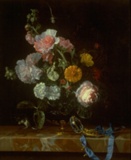 vanitas -
Latin for vanity, refers to a type of still
life consisting of a collection
of objects that symbolize death — the brevity of human life and the transience of earthly pleasures
and achievements (e.g., a human skull, a mirror,
and broken pottery).
vanitas -
Latin for vanity, refers to a type of still
life consisting of a collection
of objects that symbolize death — the brevity of human life and the transience of earthly pleasures
and achievements (e.g., a human skull, a mirror,
and broken pottery).
Such paintings were particularly popular in the sixteenth and seventeenth centuries, especially in the Netherlands.
Examples:

France, Troyes, Dance of Death, 16th century, incunabulum,
illustrated with hand-colored woodcuts,
Saxon State Library, Dresden, Germany. Based on a 14th century
morality poem by an unidentifiable author, the Dance of Death
evolved into a set of illustrated
verses depicting a dialogue
between Death and people of all social ranks. The theme
was very popular in 15th and 16th century Christian Europe, reminding
the living that rank and station in life were meaningless in
the face of death. The illustrations
show representations
of ecclesiastical and secular society being carried off by Death.
The pages displayed here show the Pope, the Emperor, a cardinal,
and a king.

Jacques de Gheyn the Elder (Dutch, 1565-1629),
Vanitas Still Life, 1603, oil
on wood panel, 32 1/2 x 21 1/4
inches (82.6 x 54 cm), Metropolitan Museum of Art, NY. See Dutch art and niche.
Pieter Claesz (Dutch, 1597/98 - 1660), Vanitas Still Life with the Spinario, 1628, oil on wood panel, 70.5 x 80.5 cm, Rijksmuseum, Amsterdam, Netherlands. See ontbijt (breakfast piece).

Willem van Aelst (Dutch, 1627-after 1682), Vanitas Flower Still Life, c. 1656, oil on canvas, 22 x 18 1/4 inches (55.9 x 46.4 cm), North Carolina Art Museum, Raleigh.
Paul Cézanne (French, 1839-1906), Still Life with Skull (Nature morte au crane), 1895-1900, oil on canvas, 21 3/8 x 25 5/8 inches (54.3 x 65 cm), Barnes Foundation, Merion, Pennsylvania. Also see Post-Impressionism.

Paul Cézanne, Pyramid of Skulls, c. 1901, oil on canvas,
14 5/8 x 17 7/8 inches (37 x 45.5 cm), private collection, Venturi
no. 753.
Vincent van Gogh (Dutch, 1853-1890), Skull with Burning Cigarette, Winter 1886/1887 (Antwerp), oil on canvas, 32.5 x 24 cm, Rijksmuseum Vincent van Gogh, Amsterdam, F 212. See Post-Impressionism.
Also see flattery and posterity.
https://inform.quest/_art